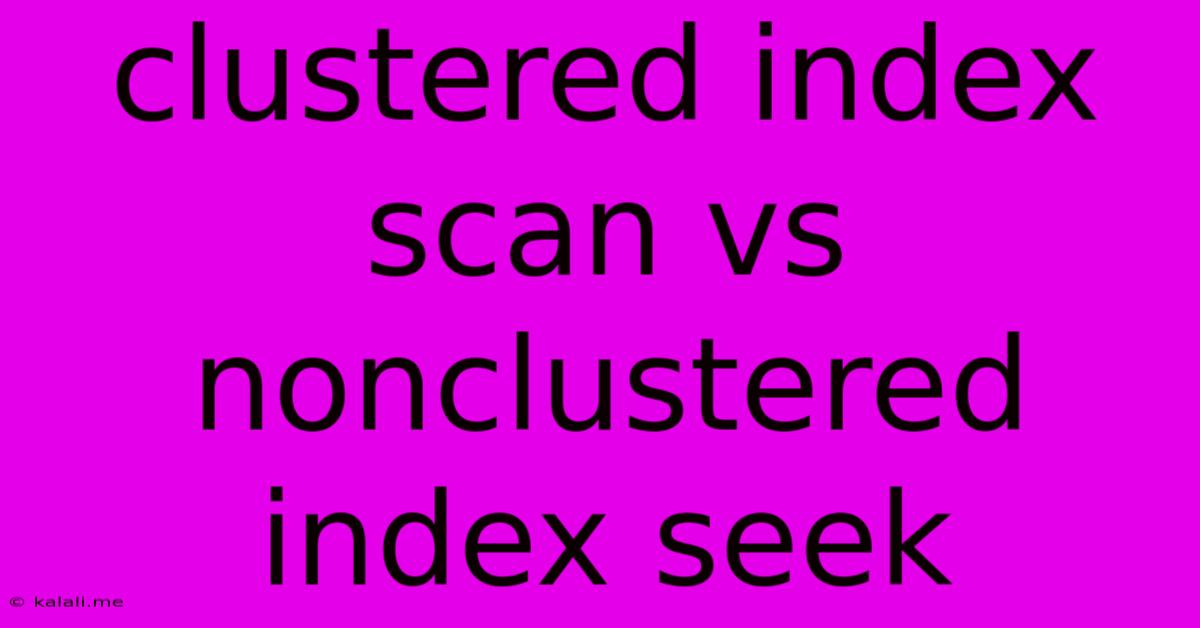Clustered Index Scan Vs Nonclustered Index Seek
Kalali
May 23, 2025 · 4 min read

Table of Contents
Clustered Index Scan vs. Nonclustered Index Seek: Understanding the Differences for Optimized Database Performance
Choosing the right query execution plan is crucial for database performance. Understanding the difference between a clustered index scan and a nonclustered index seek is fundamental to optimizing your SQL queries and ensuring efficient data retrieval. This article will delve into the specifics of each operation, highlighting their strengths and weaknesses, and helping you determine when to use each.
What is a Clustered Index?
A clustered index is a special type of index that physically sorts the data rows in a table based on the indexed columns. Think of it like the arrangement of books in a library—the books are organized by a specific order (e.g., alphabetically by author). This physical ordering allows for incredibly fast retrieval of data when querying the indexed columns. There can only be one clustered index per table.
What is a Clustered Index Scan?
A clustered index scan involves reading every row in the table based on the clustered index. This is an efficient operation when you need to retrieve a significant portion or even all of the data from the table. However, it can become inefficient if you're only looking for a small subset of the data. This would lead to unnecessary I/O operations and increased query execution time.
Use Cases for Clustered Index Scans:
- Full table scans: When you need to retrieve all rows from the table.
- Range queries involving the clustered index key: When you are searching for data within a specific range of the clustered index column(s). For instance, retrieving all customers who registered between two specific dates, assuming the
registration_dateis part of the clustered index. - Aggregate functions: When calculating aggregate values (SUM, AVG, COUNT, etc.) across the entire table or a substantial portion of it.
What is a Nonclustered Index?
Unlike a clustered index, a nonclustered index doesn't physically reorganize the data rows. Instead, it creates a separate structure containing pointers to the actual data rows. Think of it as a detailed index in the back of a book—it points to the page number where you can find the relevant information, but the information itself is still located on that specific page in the book. You can have multiple nonclustered indexes on a single table.
What is a Nonclustered Index Seek?
A nonclustered index seek involves using a nonclustered index to locate the specific row(s) you are looking for. It uses the index to quickly identify the relevant data row pointers, significantly reducing the number of data pages the database needs to access. This is incredibly efficient for targeted queries.
Use Cases for Nonclustered Index Seeks:
- Point queries: When you're looking for a specific row based on a unique identifier (e.g., retrieving a customer's information using their customer ID).
- Queries with equality predicates: When searching for rows matching specific criteria (e.g., finding all orders with a status of "Shipped").
- Queries with filtering conditions on the indexed columns: These queries benefit significantly because the index allows for quick filtering before retrieving the actual data rows.
Clustered Index Scan vs. Nonclustered Index Seek: A Comparison
| Feature | Clustered Index Scan | Nonclustered Index Seek |
|---|---|---|
| Data Access | Reads entire table (or a range) | Reads only necessary rows |
| Efficiency | Efficient for large data retrieval | Efficient for specific data retrieval |
| Index Type | Requires a clustered index | Requires a nonclustered index |
| I/O Operations | High | Low |
| Best Use Cases | Full table scans, range queries | Point queries, equality predicates |
Choosing the Right Approach:
The optimal approach depends entirely on the specific query and the underlying data. Carefully analyze your queries and consider creating indexes strategically to leverage the power of both clustered index scans and nonclustered index seeks. A good query execution plan often uses a combination of both. Understanding the behavior of each operation is key to crafting high-performance database applications. Monitoring your query execution plans using tools provided by your database system is essential for continuous optimization and fine-tuning. Efficient database operations directly impact the overall responsiveness and scalability of your application.
Latest Posts
Latest Posts
-
How Many Cups Is 1 Pound Of Cheese
Jul 12, 2025
-
30 X 30 Is How Many Square Feet
Jul 12, 2025
-
How Much Does A Half Oz Weigh
Jul 12, 2025
-
Calories In An Omelette With 3 Eggs
Jul 12, 2025
-
How Do You Say Great Grandmother In Spanish
Jul 12, 2025
Related Post
Thank you for visiting our website which covers about Clustered Index Scan Vs Nonclustered Index Seek . We hope the information provided has been useful to you. Feel free to contact us if you have any questions or need further assistance. See you next time and don't miss to bookmark.